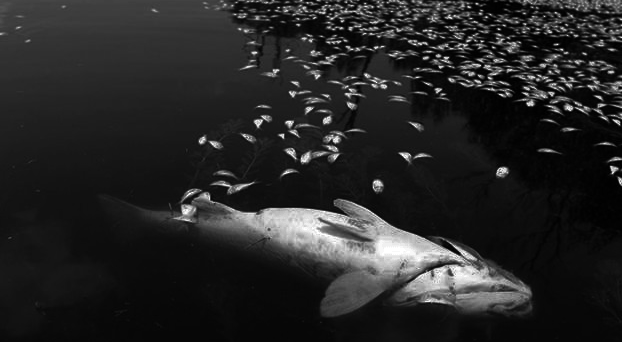By Nancy Smith for The Sunshine State News
[dropcap]T[/dropcap]housands upon thousands of dead and rotting fish float belly-up in the polluted Indian River Lagoon, devastating indictors of the state’s failure to control nutrient levels in one of the most bio-diverse waterways in the country.
“They were suffocated. They could not breathe,” Robert Weaver, Ph.D., director of the Indian River Lagoon Research Institute, said of the blanket of fish stretching as far along a 50-mile waterfront as the eye could see. He said at 2 a.m. Saturday there was no oxygen at the depth of water where he was taking samples near Sykes Creek in Merritt Island.
Brian Lapointe, Ph.D., marine algae specialist and research professor at Florida Atlantic University’s Harbor Branch Oceanographic Institute, told Sunshine State News the algae blooms and brown tide represent a perfect storm of high levels of fecal coliform, El Nino gullywashers bringing other polluted runoff, a sudden spike in temperatures and a depletion of oxygen levels for fish and other marine wildlife.
“This meltdown of the Indian River Lagoon starts way up in Volusia County,” Lapointe explained Monday. “The bloom and brown tide actually began last fall in the North and moved south. It hit the Sebastian Inlet area in early February 2000. Measurements for biomass in the water included 200 mg. per liter of chlorophyll A — that’s a big, big bloom.
“All those algae blooms die and strip the oxygen out of the water,” he said. “The low oxygen is exacerbated by the temperature spike.”
Could this devastation have been prevented? Lapointe was emphatic. “Absolutely,” he said. “The problem is, there is so much bad information out there, so much emotion and politicizing of the issue and so little emphasis on real science. Go back 26 years and look at the Indian River Lagoon Act. It identifies sewage hot spots. They knew human waste was a major problem even back then, but nobody wanted to deal with the issue. People wanted to keep their septic tanks, the status quo was cheaper than converting to a central sewage system.”
The exception was Port St. Lucie.
By 1990 the city of Port St. Lucie was converting its utilities — water and sewer — to a central municipal system. It was a painful process — each homeowner had to foot the bill to construct the system, the state never provided a dime. “It was the largest wastewater septic tank conversion in the country,” PSL Mayor Gregory J. Oravec told SSN.
But, even though the entire city was converted by about 1996, residents were told they didn’t have to hook up until their well fields failed — meaning water improvement in drainage canals and the North Fork of the St. Lucie River was slow in improving for the first 10 years.
According to PSL Utilities Department figures, there are —
- 18,664 active residential septic systems in the city and another 1,131 systems in use within portions of unincorporated St. Lucie County that lie within the city’s utility service area;
- 50,024 sanitary sewer service customers being billed as of February 2016.
“We’re trying to identify the sources of our pollution,” Oravec said. “A lot of it is fecal coliform, that we know, and it’s discouraging. We’ve asked Brian Lapointe to help us find the source.”
The Indian River Lagoon is 156 miles (251 km) long, extending from Ponce de León Inlet in Volusia County to Jupiter Inlet in Palm Beach County. It includes Cape Canaveral. Lake Okeechobee is connected to the lagoon by the Okeechobee Waterway and where the St. Lucie River and Indian River meet in Sewall’s Point.
In 2008 there were an estimated 300,000 septic tanks along the watershed route of the Indian River Lagoon; today there are 600,000.
“You just can’t blame Lake Okeechobee phosphorus for this brown tide,” Lapointe said. “The official warning was not to touch the water in the North Fork. If Okeechobee were responsible, there would have been a warning not to touch the water in the South Fork. And there wasn’t.”



![By Prys2010 (Own work) [Public domain], via Wikimedia Commons](https://flylifemagazine.com/wp-content/uploads/2016/03/Dead-600x330.png)